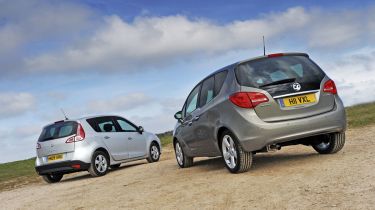Meriva vs. Scenic
Our compact MPV favourite provides a stiff challenge to the Vauxhall newcomer
If the Meriva was too expensive to beat the Kia, perhaps it will fare better against bigger and more costly opposition... The original Renault Scenic set the template for the modern compact MPV when
it debuted in 1997, and the latest car still leads the way.
A blend of brilliant packaging, attractive looks and affordable running costs has made it an Auto Express favourite, as well as a big hit in showrooms.
The Scenic is bigger than the Meriva in every dimension, but the neat styling helps to disguise its larger proportions. The major difference is in the middle, where the Renault has conventional, albeit wide-opening, rear doors. Yet while they don’t give the same great access as the Vauxhall’s, the French car compensates with its more spacious interior.
In the back, there are three equally sized seats, which slide and fold independently. Add the flat floor, and it’s more spacious and comfortable for three people – the Vauxhall’s FlexRail system takes up valuable space in front of the middle rear seat.
Versatile
The Scenic’s boot also has the edge. On paper, the difference doesn’t appear that big – with the back seats in place, the 437-litre area is only 37 litres bigger than the Meriva’s. But the Vauxhall’s total includes the awkwardly shaped (and empty) spare wheel well beneath the boot floor. The Scenic’s spare is slung under the boot, so it provides more usable space.
Used - available now

2025 BMW
iX
81,249 milesAutomaticElectric
Cash £26,272
2022 BMW
i3
33,096 milesAutomaticElectric
Cash £14,032
2025 Toyota
Yaris Hybrid
26,859 milesAutomaticPetrol1.5L
Cash £14,935
2022 Volvo
XC40
48,424 milesAutomaticPetrol1.5L
Cash £19,705And when you need to maximise load capacity, the Renault can perform a neat trick: its back seats fold, tumble or can be removed altogether. If you take them out there’s a van-like 1,837-litre space – a massive 337 litres more than the Meriva. Its front passenger seat also folds flat for carrying extra-long items.
The Renault leads the way on space, then, but can it match the Meriva for interior quality? With switchgear passed down from the Insignia and Astra, including classy, chrome-rimmed dials, the Vauxhall feels incredibly grown-up inside. In contrast, the Scenic is much more fun – but not at the expense of quality. In particular, the dashboard is finished in a really tactile soft-touch plastic.
The fun element comes from the instrumentation, which is mounted centrally and incorporates a digital rev counter/speedometer. It means children travelling in the back will be able to see just how fast mum or dad is driving! The person at the wheel can also choose from four different combinations of analogue or digital-style read-outs.
The Renault’s biggest weakness inside is the sporadic layout of some of the switchgear and the controls for the stereo, which are over-complicated and confusing. But it’s the more family friendly choice, with storage cubbies in the floor, sliding trays underneath the two outer rear seats, roller blind-style sunblinds for rear passengers and more practical door pockets.
In addition, it comes with more equipment as standard. Our Dynamique TomTom model has sat-nav (an £835 extra in the Meriva) – so the Renault’s higher price begins to make sense.
The Meriva SE counters by including a panoramic glass sunroof. A similar set-up in the Renault is a £615 optional extra, although its front section opens, unlike in the Vauxhall.
Hit the road, and the Scenic stretches its advantage. As our figures show, it is faster than the Meriva – it covered 0-60mph in 10.2 seconds, which is three-tenths faster. Plus, its powerful 1.4-litre turbo engine is a much more willing performer.
With six gear ratios to choose from, it’s livelier from behind the wheel. The five-speed Vauxhall feels as if it has been tuned to optimise economy rather than performance. It needs to be worked hard, and even then it struggles to keep pace with the faster Renault.
The Scenic is more fun to drive, too. Its engine thrives on revs and the nimble chassis delivers greater handling agility, without compromising ride quality. Lighter steering also ensures it is the easier car to manoeuvre at low speeds, while it’s quieter and more relaxing than the Vauxhall on the motorway, too.
But the Meriva makes up ground on cost – as it undercuts its roomier, better equipped rival by £575. We were unable to get meaningful fuel economy figures during our limited time with the Vauxhall, but its combined fuel return of 46.3mpg is also better than Renault’s claimed 39.8mpg.
Lower CO2 emissions bring cheaper tax bills for private and company buyers choosing the Meriva, so this is a closely fought contest. But will the Scenic’s extra cabin space prove decisive?
Details
WHY: The Scenic started the compact MPV craze, and the latest version is still our favourite five-seat people carrier. But is this great family buy about to lose its crown?







